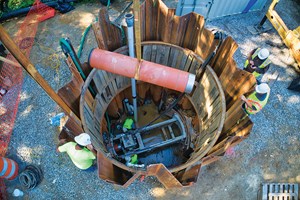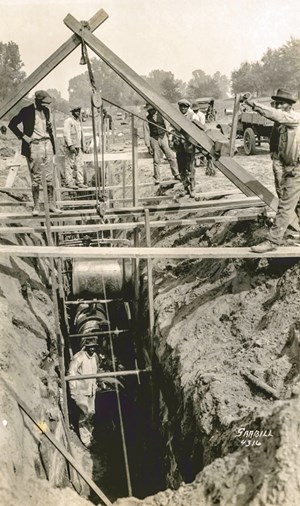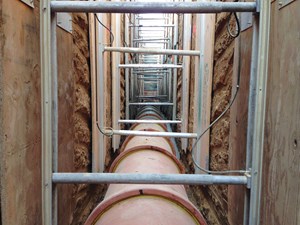August 2020 Vol. 75 No. 8
Features
Clay Pipe Gets Better with Age: In a World of Plastics, Clay Pipe Still Stands Out
Jeff Griffin | Senior Editor
Most people involved in utility construction know clay pipe has been around for a long time – thousands of years, in fact, beginning in 4000 B.C. in Babylonia. It has been used in the United Kingdom since the late 1600s.
Vitrified clay pipe (VCP), first used in the United States more than 200 years ago, continues to be widely used today. Primarily application is for gravity sanitary sewer systems installed by cut-and-cover construction, but it also can be installed by trenchless pipe jacking, slurry microtunneling, pilot tube guided boring, and static pipe bursting.
Those who think advances in plastics have made clay pipe obsolete might want to reconsider.
“Over the last several years, the demand for VCP has increased due to a strong economy, plus new market areas,” said Jeff Boschert, P.E., president of National Clay Pipe Institute (NCPI). “Manufacturers today are running close to their capacity, as well as building new kilns to keep up with the demand trend.”
Boschert believes two factors help drive that trend: VCP offers the longest service life of any pipe material available, and it has the durability to withstand the most aggressive methods of cleaning. Other factors combine with these two, to make VCP the best, most cost-efficient pipe for sanitary sewer systems, he claims.
“VCP is a fired ceramic and is the only pipe that will not deteriorate over time in a sanitary sewer environment,” Boschert said. “Plastics lose strength as they age, and concrete and iron pipes are susceptible to corrosion from the hydrogen sulfide present in sewer pipes. The physical properties of clay pipe, however, never change, providing the longest service life of any pipe material available.”
Composition
Clay pipe products are made from various types of shale and clay, which are the natural decomposition product of stone. It is an abundant, naturally occurring group of materials found all over the country. All that is added is a little water.
Compression and heat are applied to the raw materials to convert them into a chemically inert ceramic. There is zero waste generated in the process and total embodied energy is roughly half that of manufacturing other sewer pipe materials.
“Vitrified clay pipe is as close to permanent as any material can be for gravity sewer applications,” Boschert pointed out. “Due to VCP’s long life cycle, and the fact that it is chemically inert and does not change over time, there are no long-term disposal or decay concerns.”
Boschert reports that VCP has a 9 rating on the Mohs hardness scale and an average compressive strength of 18,000 pounds per square inch.
All common methods of cleaning sewer lines can be safely used in VCP sewer pipe including hydro-mechanical tooling, hydro-flush nozzles, mechanical rodding, bucketing and chain/cable type cutters. These aggressive cleaning methods have been instrumental in successful programs to reduce SSOs.
Open cut and trenchless
VCP is available in diameters from 4 to 42 inches for open-cut construction.
“The open-cut bell/spigot and plain-end pipe market has the lion’s share (95 percent) of VCP supplied,” Boschert said. “Trenchless installations with clay jacking pipe have significantly smaller diameters, but they continue to grow in number, as more people learn about their benefits. Jacking pipe comes in diameters from 8 to 24-inches.
“Vitrified clay jacking pipe cannot be installed by horizontal directional drilling (HDD). Both slurry microtunneling and pilot tube guided boring are appropriate new installation methods for gravity flow projects, due to their guidance capabilities,” he added. “VC jacking pipe can be utilized for both these installation methods, as well as for the replacement pipe in static pipe bursting.”
What does the future hold for VCP?
“We’re projecting continued growth, as more municipalities are realizing the benefits of installing their sanitary sewers just once,” Boschert explained.
“As some systems have undertaken CMOM (capacity, management, operations, and maintenance) or asset management inspections to evaluate the condition of their sewers, they are realizing that the old, clay pipe in their system is some of their best pipe.
“When they look at that, as well as the cost to install and maintain any sewer pipe, the future is bright for VCP.” •
What Users Say About Clay Pipe
Engineering
In New York City, vitrified clay pipe (VCP) is specified for all sewers (storm, sanitary and combined) that are 18 inches or less in diameter, said George Cowan, P.E., former assistant commissioner-Infrastructure Division, New York City Department of Design and Construction.
“Current specifications,” he added. “only permit the cut and cover method for clay pipe, although other methods such as the pilot tube method, have been used due to circumstances and certain restriction.
“I do not personally know of any issues during cleaning the clay pipe.
“Based upon my 50 years in sewer construction and maintenance, I believe clay to be the best choice due to its performance over time,” Cowan added.
Municipality
In California, Chad Rocha of the Morro Bay Division, city of Morro Bay, reports that about 65 percent of the city’s sanitary sewer system is vitrified clay pipe, most of it 6 inches in diameter.
He believes VCP’s ability to withstand high-pressure water for cleaning purposes is an important benefit of clay pipe.
Contractor
Grbcon Inc. is a contractor specializing in sewer and storm drain pipeline construction in Southern California.
Vice President John W. Gavigan says Grbcon uses open-cut construction to remove and replace old pipe with VCP.
“In heavily populated urban areas with numerous other utilities in the public right-of-way,” Gavigan explained, “shorter lengths of VCP make it easier to install near conflicting utilities. VCP also is a better host pipe if an agency decides to rehabilitate its mainline pipe with CIPP sometime in the future.” •







Comments